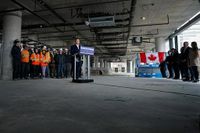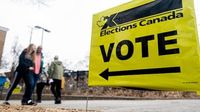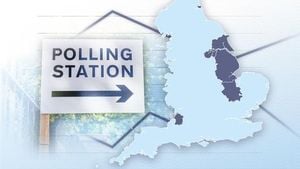With less than a week until election day, the political landscape in Canada is heating up as party leaders ramp up their campaigns. On April 22, 2025, Conservative Leader Pierre Poilievre is set to unveil his costed campaign platform, making him the last major party leader to do so. This announcement comes just after advance polls have closed, adding urgency to the final stretch of the 36-day federal election campaign.
Poilievre's platform release is highly anticipated, particularly as it promises to outline the specifics of his party's financial commitments and proposed cuts. He will appear at a "Canada First" rally in Vaughan, Ontario, later in the day, aiming to rally support as the Conservatives attempt to close the gap with the Liberals, who currently hold a six-point lead in the polls.
NDP Leader Jagmeet Singh is also making moves, with an announcement planned in Vancouver before heading to Edmonton for an evening event with former Alberta premier Rachel Notley. Meanwhile, the Canadian Automobile Dealers Association is preparing to share recommendations for the next federal government, focusing on how to keep Canada's auto industry competitive amid looming U.S. tariffs.
According to a three-day rolling sample by Nanos Research conducted between April 19-21, the Liberals are leading with 43 percent of voter support compared to the Conservatives at 37 percent. Nik Nanos, the official pollster for CTV News and the Globe and Mail, noted that two key groups—middle-aged voters and those in British Columbia—are still considered toss-ups, which could sway the election outcome.
Regionally, the Liberals are performing well in the Atlantic provinces, Ontario, and Quebec, while the Conservatives maintain their strength in the Prairies. B.C. is currently a dead heat, reflecting the competitive nature of this election.
In terms of leadership preferences, Liberal Leader Mark Carney holds a significant 13-point advantage over Poilievre, with 47 percent favoring Carney compared to 35 percent for Poilievre. Singh trails far behind, garnering only six percent support.
As Poilievre prepares to release his platform, he has faced questions regarding the timing of its announcement. Critics have suggested that the delay may be linked to difficulties in finalizing the financial details of his ambitious agenda. However, Poilievre has dismissed these claims, asserting that the timing is not related to accounting issues.
His platform is expected to include a "pay-as-you-go" or "dollar for dollar" law, which would require any new government spending to be matched by cuts elsewhere in the budget. This approach is designed to reassure voters about fiscal responsibility, especially given the party's proposals for significant spending increases.
Among the key promises in Poilievre's platform is a "middle-class tax cut" amounting to $14 billion annually, which is more generous than the tax relief proposed by Carney. Furthermore, Poilievre's housing agenda includes a plan to scrap the Goods and Services Tax (GST) on all new homes, a move projected to cost the federal treasury between $3.96 billion and $4.97 billion per year. He has also pledged to build 2.3 million new homes across Canada over the next five years.
To support this housing initiative, Poilievre intends to reward municipalities that reduce development charges with federal funding, which is estimated to cost around $1.56 billion annually. Additionally, he has committed to increasing defense spending to meet NATO's target of two percent of GDP by 2030, representing another significant financial commitment.
Poilievre's plans also include deferring capital gains tax for investors who reinvest their profits back into Canada, which could cost the government approximately $5 billion each year for the next two years. He has stated that his platform will clarify where cuts will be made to fund these initiatives, promising to eliminate waste and reduce taxes while boosting home construction and public safety.
However, the Liberals have raised concerns about the feasibility of Poilievre's promises. They argue that his "dollar for dollar" commitment implies that the Conservatives will need to make substantial cuts to fund their proposed $140 billion in new spending. Liberal candidate François-Philippe Champagne has called for Poilievre to clarify which programs will be affected and how his cuts might impact vulnerable Canadians.
In response, Poilievre has characterized the Liberal critique as misleading. He claimed, "Whenever Liberals present you with the numbers, you should be afraid, very afraid, because their numbers are always wrong." He has also indicated that he plans to cut $10 billion in spending on outside consultants, although the specifics of these cuts remain vague.
During a campaign event in Toronto, Poilievre expressed his commitment to a Conservative government that would prioritize economic growth and fiscal responsibility. He emphasized the need for a change from what he described as the Liberal government's record of rising taxes, inflation, and crime.
As the election approaches, the stakes are high for all parties involved. With Poilievre's platform set to be released today, voters will soon have a clearer picture of the Conservative Party's vision for the future. Will it be enough to sway undecided voters and close the gap with the Liberals? Time will tell as Canadians prepare to head to the polls on April 28, 2025.








